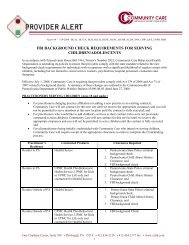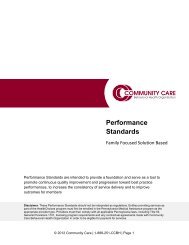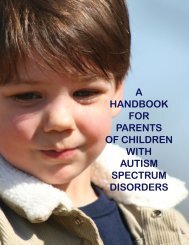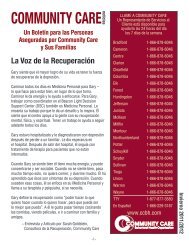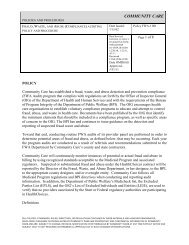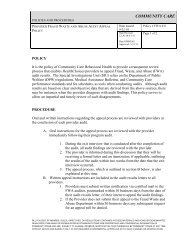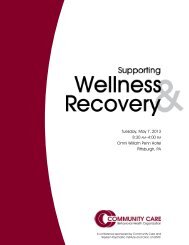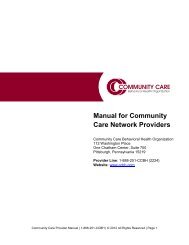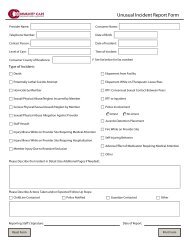a handbook for parents of children with autism spectrum disorders
a handbook for parents of children with autism spectrum disorders
a handbook for parents of children with autism spectrum disorders
- No tags were found...
You also want an ePaper? Increase the reach of your titles
YUMPU automatically turns print PDFs into web optimized ePapers that Google loves.
APPENDIX A:DIAGNOSTIC CRITERIA –AUTISM SPECTRUM DISORDERThe earlier adiagnosis <strong>of</strong>Autism is made,the better thechances are<strong>of</strong> a personreceivingappropriatehelp andsupport.The “Autism Spectrum Disorder” is widely defined to include the entire range <strong>of</strong>pervasive developmental <strong>disorders</strong> that are seen in <strong>children</strong> and adolescents (frombirth up to the age <strong>of</strong> 21). Autistic Disorder is defined in the current version <strong>of</strong> theAmerican Psychiatric Association’s Diagnostic and Statistical Manual (DSM-IV-TR) as:A. A total <strong>of</strong> six (or more) items from (1), (2), and (3), <strong>with</strong> at least two from (1) andone each from (2) and (3):(1) Qualitative impairment in social interaction as manifested by at least two <strong>of</strong> thefollowing:a. Marked impairment in the use <strong>of</strong> multiple nonverbal behaviors, such aseye-to-eye gaze, facial expression, body postures, and gestures to regulatesocial interaction.b. Failure to develop peer relationships appropriate to developmental levelc. A lack <strong>of</strong> spontaneous seeking to share enjoyment, interests, orachievements <strong>with</strong> other people (e.g., by a lack <strong>of</strong> showing, bringing, orpointing out objects <strong>of</strong> interest).d. Lack <strong>of</strong> social or emotional reciprocity.(2) Qualitative impairments in communication as manifested by at least one <strong>of</strong> thefollowing:a. Delay in or total lack <strong>of</strong> the development <strong>of</strong> spoken language (notaccompanied by an attempt to compensate through alternative modes <strong>of</strong>communication such as gesture or mime).b. In individuals <strong>with</strong> adequate speech, marked impairment in the ability toinitiate or sustain a conversation <strong>with</strong> others.c. Stereotyped and repetitive use <strong>of</strong> language or idiosyncratic language.d. Lack <strong>of</strong> varied, spontaneous make-believe play or social imitative playappropriate to developmental level.(3) Restricted, repetitive, and stereotyped patterns <strong>of</strong> behavior, interests, andactivities as manifested by at least one <strong>of</strong> the following:a. Encompassing preoccupation <strong>with</strong> one or more stereotyped and restrictedpatterns <strong>of</strong> interest that is abnormal either in intensity or focus.b. Apparently inflexible adherence to specific, nonfunctional routines or ritualsc. Stereotyped and repetitive motor mannerisms (e.g., hand or finger flappingor twisting, or complex whole-body movements).d. Persistent preoccupation <strong>with</strong> parts <strong>of</strong> objects.B. Delays or abnormal functioning in at least one <strong>of</strong> the following areas, <strong>with</strong> onsetprior to age 3 years:(1) social interaction.(2) language as used in social communication.(3) symbolic or imaginative play.- Page 30 -



